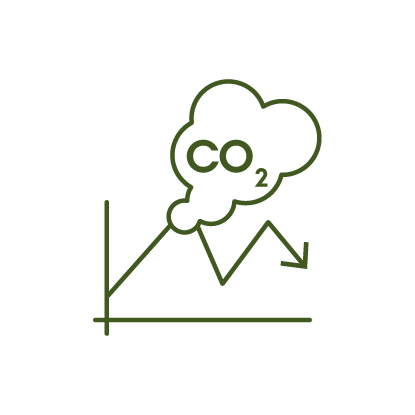Good points in the AU greenhouse gas emissions report for 2019
AU's greenhouse gas emissions report (GHG emissions report) for 2019 shows a total reduction in university carbon emissions of 15 per cent compared with 2018. Gratifying – but there is still a lot to do, says University Director Arnold Boon. The journey towards an even greener university has only just begun.

The university’s first GHG emissions report was published a year ago, and the next is now ready. The new report shows that AU's total carbon emissions have fallen by 15% from 2018 to 2019. University Director Arnold Boon is pleased with the result:
"This is the first time we’ve been able to measure trends in our carbon emissions, and this in itself has been worth looking forward to. The GHG emissions report is an important tool in our journey towards a greener university, and with a reduction of 15 per cent, we have a good starting point for achieving the target in our climate strategy of a 35 per cent carbon reduction by 2025," says Arnold Boon.
In general terms, the 2019 report shows reductions in a number of different areas. Much of the total fall is in emissions by the university associated with the purchase of electricity and heating. These have been reduced significantly, in part due to increased wind production in Denmark. There is also a significant reduction in direct emissions from AU because of more climate-friendly heat production with biogas and wood pellets rather than oil and gas. Furthermore, there has been a reduction in water consumption by the university, and in the number of kilometres flown.
Carbon-saving activities launched
"Even though we've got off to a good start, there's still a lot we as a university can and should be getting to grips with," says Arnold Boon, and he continues:
"The goal of our climate strategy can only be achieved if we focus our work on reducing carbon emissions. Therefore, I’m very much looking forward to following developments in the years to come, when I hope we will begin to see reductions stemming directly from the various carbon-saving activities we’ve launched on the basis of our climate strategy. These include phasing out our almost 200 diesel and petrol cars, and introducing a fixed temperature of 21 degrees centigrade in cold months."
Arnold Boon also expects that the Covid-19 situation will be clearly reflected in next year's report.
"We're going to see carbon reductions in 2020, among other things because of significantly less air travel and less transport in general. As a positive consequence of Covid-19, I hope that we’ll be able to maintain some of the new habits that have helped pull our climate efforts in the right direction."
A dynamic tool
Up to the university's next GHG emissions report, future new aspects to be included in the report will be examined, and methods for further development will be considered.
One of the topics expected to be discussed is whether biomass emits CO2. AU bases its work on the UN Intergovernmental Panel on Climate Change (IPCC) and, according to the panel, biomass does not emit CO2. The Danish Centre for Environment and Energy (DCE), which has drawn up the university's GHG emissions report, is closely monitoring the debate and it will correct the calculation method if the IPCC changes its perception. If this happens, it will have an impact on AU’s results.
FACTS about the GHG emissions report
Aarhus University's GHG emissions report is based on the Greenhouse Gas Protocol (GHS), which is a recognised method of calculating emissions of greenhouse gases, converted into CO2 equivalents and allocated between three so-called scopes:
- Direct emissions from the university's property, e.g. from boilers or combined heat and power production at AU, as well as in connection with the use of motor vehicles and operating the research vessel Aurora.
- Indirect emissions related to the university's purchase of, heating, electricity and cooling, for example.
- Value-chain emissions, including air travel, water consumption and emissions in the agricultural sector.
Further information
- Read about the AU greenhouse gas emissions report for 2019 and relevant definitions (in Danish).
- Read news articles about:
- If you have any questions, you are welcome to send an email to sustainability@au.dk og learn more at m.au.dk/sustainability.
